
US #3134
1997 Thornton Wilder – Literary Arts Series
- Commemorates the 100th anniversary of the birth of Thornton Wilder
- 14th stamp in the Literary Arts Series
Stamp Category: Commemorative
Series: Literary Arts
<... more
US #3134
1997 Thornton Wilder – Literary Arts Series
- Commemorates the 100th anniversary of the birth of Thornton Wilder
- 14th stamp in the Literary Arts Series
Stamp Category: Commemorative
Series: Literary Arts
Value: 32¢, First Class Mail Rate
First Day of Issue: April 17, 1997
First Day City: Hamden, Connecticut
Quantity Issued: 97,500,000
Printed by: Ashton Potter (USA) Ltd.
Printing Method: Offset, Microprint (“OUR TOWN” vertically on the left corner of the house above Wilder’s left shoulder)
Format: Panes of 20 (horizontal 4 across, 5 down)
Perforations: 11.1
Tagging: Phosphored paper
Why the stamp was issued: To commemorate the 100th birth anniversary of playwright, novelist, and Pulitzer Prize-winner Thornton Wilder.
About the stamp design: Based on an oil painting by Michael Deas. The design pictures Thornton Wilder with his chin resting in his folded hands. The background includes images of rolling green hills, a church, house, and farm buildings, symbolizing Grover’s Corners, the setting for Wilder’s famous three-act play Our Town. In the far distance are blue mountains set against a mauve and orange sky at sunset.
Special design details: Wilder’s family requested tiny gravestones be added to the churchyard to represent the iconic funeral scene in Our Town. Deas had considered this beforehand, but ultimately decided against it due to the size of the stamp. He worried the stones would have been too tiny to read correctly and might’ve resembled printing errors instead. The family’s request was carefully turned down.
First Day City: The First Day of Issue Ceremony was held at Thornton Wilder Hall of Miller Central Library in Hamden, Connecticut.
About the Literary Arts Series: The Literary Arts Series began in 1979 with a John Steinbeck stamp. The objective of the Literary Arts Series is to honor America’s most renowned authors. As the USPS put it, “These skillful wordsmiths spun our favorite tales – and American history along with them.” The series honors both well-known and lesser-known authors, making it like an encapsulation of America’s rich and varied literary history.
History the stamp represents: Well known for his innovative novels and plays, Thornton Wilder was born and raised in Madison, Wisconsin – one of the nation’s most progressive states. He was keenly interested in the people around him and acutely aware of the universal truths of human nature – many of which are reflected in his work.
Wilder first achieved success in 1927 with his novel The Bridge of San Luis Rey, and later went on to complete six other novels. However, the theater was his first love. He began writing for the stage in 1915, later stating “…the theater carries the art of narration to a higher power than the novel or the epic poem.” This belief no doubt led him to experiment with engaging the audience in the drama by having the actors speak directly to the spectators, and by minimizing props and scenery.
His sensitive drama about life and death in a New England town, Our Town (1938), is considered his masterpiece. And his 1938 farce The Merchant of Yonkers, was later adapted into the immensely successful musical Hello Dolly! Wilder received Pulitzer Prizes in 1928 for his novel The Bridge of San Luis Rey and in 1938 and 1943 for the plays Our Town and The Skin of Our Teeth, making him one of the few writers to have the distinctive honor of receiving Pulitzers in both fields.









